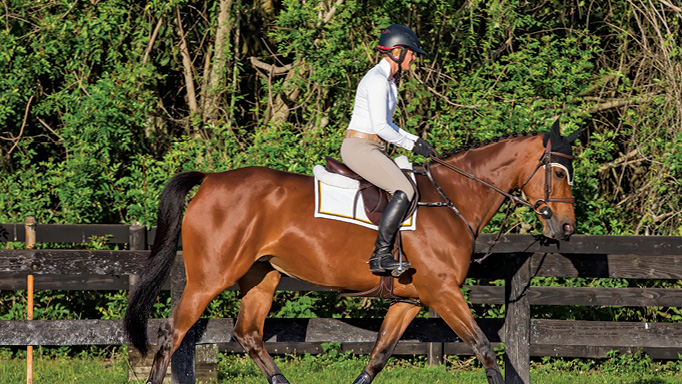When I think about good riding, the first thing that comes to my mind is a good, strong position. To me, position is everything, and the basis for any training you want to achieve. The question of achieving good balance cannot even begin to be discussed unless every day you are working on the basics of horsemanship and position.
To achieve balance with your horse, you need to ride in your best position, which makes you a strong and effective rider. Every rider’s natural balance is different, so you must also consider suitability. There are many factors to consider: your height, weight, arm length, leg length, upper body length and natural physical strength play a role. We look at the horse and rider’s conformation to determine if they are an ideal match.
It is also important to determine suitability of the horse’s temperament and ability to the rider. Carimba [the eight-year-old mare used as a model for these exercises] would be described as a horse for a professional and is not well suited for an amateur rider. She is very hot and sensitive; in the warmup ring she is very nervous of the other horses and you have to be safe and protect her confidence. For myself, she is the perfect type!
The other type of suitability that plays a role is suitability for the job. You have to have the right horse for the level you wish to achieve as a rider.
Evaluating the Horse
Evaluate your horse: is he light or heavy, hot or cold, low-balanced or high-headed? It is important to recognize that a low-balanced horse will never be capable of a ‘high frame’ and work with what you have.
Every time I sit on a horse, I let them tell me what is easy for them and what is harder. From there, I find a way to create the best balance possible using all the variables that the partnership of horse and rider create.
Work with the balance your horse has naturally. When we get a young or new horse into the program, I evaluate the horse’s mouth and level of experience before I begin to work on balance, which in my mind is really a combination of stride control, rideability, and working with the horse’s natural way of going to achieve optimal performance.
Of course, there are tricks and equipment that exist to help improve your horse; you can use special bits, martingales, draw reins; you can train on the lunge line and even work on some basic dressage training. But you can easily over-train and frustrate your horse and do more harm than good when you choose gimmicks over working on a consistent program.
What is Balance?
Balance in the horse is achieved when it is travelling at all gaits with weight evenly distributed over all four legs, not on the forehand (“downhill”) or too much on the hind end (“climbing”).
“Balance for me is when a horse carries himself,” explains Ballard. “He stays in the rhythm you want and gives the rider the best possible chance to make a good jump. In perfect balance you can be fast, make the hardest turns, and have the ability to ride smoothly. I would say it is the most difficult aspect of horse training, but if you can perfect it, the reward is huge!”
From the rider’s perspective, balance can be defined as finding the “sweet spot” over the horse’s centre of gravity (CoG), which is located just behind the withers, neither tipping forward nor being left behind. This CoG shifts slightly forward at higher speeds, and backwards depending on the level of collection (such as in dressage movements or preparing to jump). Balance involves all three planes of the rider’s position – left/right, front/back, up/down – and requires core strength, suppleness, flexibility, coordination, focus, feel, and timing.

